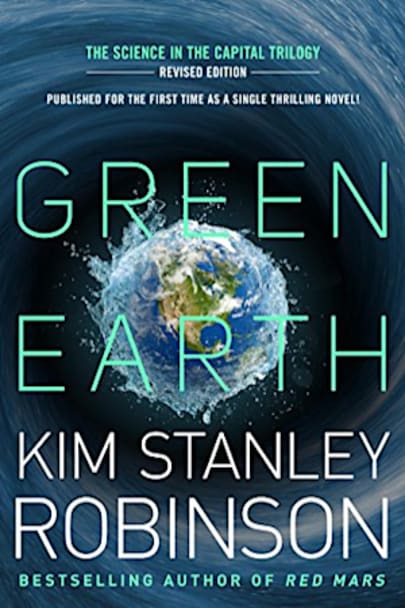The landmark trilogy of cutting-edge science, international politics, and the real-life ramifications of climate change—updated and abridged into a single novel More than a decade ago, bestselling author Kim Stanley Robinson began a groundbreaking series of near-future eco-thrillers—Forty Signs of Rain, Fifty Degrees Below, and Sixty Days and Counting—that grew increasingly urgent and vital as … grew increasingly urgent and vital as global warming continued unchecked. Now, condensed into one volume and updated with the latest research, this sweeping trilogy gains new life as Green Earth, a chillingly realistic novel that plunges readers into great floods, a modern Ice Age, and the political fight for all our lives.
The Arctic ice pack averaged thirty feet thick in midwinter when it was first measured in the 1950s. By the end of the century it was down to fifteen. One August the ice broke. The next year the breakup started in July. The third year it began in May. That was last year.
It’s a muggy summer in Washington, D.C., as Senate environmental staffer Charlie Quibler and his scientist wife, Anna, work to call attention to the growing crisis of global warming. But as they fight to align the extraordinary march of modern technology with the awesome forces of nature, fate puts an unusual twist on their efforts—one that will pit science against politics in the heart of the coming storm.
Praise for the Science in the Capital trilogy
“Perhaps it’s no coincidence that one of our most visionary hard sci-fi writers is also a profoundly good nature writer—all the better to tell us what it is we have to lose.”—Los Angeles Times
“An unforgettable demonstration of what can go wrong when an ecological balance is upset.”—The New York Times Book Review
“Absorbing and convincing.”—Nature
more



Forty Signs of Rain was the first Kim Stanley Robinson book I ever read and I was so impressed I immediately read the other two books in the trilogy then everything else Robinson had available at the time. Set in near-future Washington, D.C., the trilogy explores the effects of climate change and the political issues when the current administration is in denial (sound familiar?). The characters are well-fleshed out and the story is gripping. All three of the Science in the Capital books are included in this edition, so you can binge read the entire trilogy.
A little slow and the hero is a bit implausible in his denseness but still a fun read. Not preachy but a definite warning about the path that we may be going down with climate change.
I loved this consolidation of three books that describes how we might survive the devastating effects of climate change. Even though it describes some terrible possibilities I was left with hope for us and the future. The story is told not just through description of the conditions but through the characters: scientists, politicians, survivors and just plain people, who dealt with those conditions, sometimes successfully and sometimes not.
KSR wrote a very informative sci find book. Interesting plot, lots of good science woven in with the fictional plot. This one is a winner.
Read it, it is well worth your time.
I kept looking for more action. The premise is that the world is in trouble because of global warming, but not enough “trouble” was developed in the plot line. The author got too involved in the science and the scientist personalities to develop the story line. I was disappointed.
climate change in DC
I couldn’t put it down, the events both achingly mundane and smoldering horrific events, and yet what we should expect any time now. There is hope, but you have to take the journey to understand.
It would have been nice if, when condensing his original trilogy, Robinson had chosen to leave in more of the hard science and less romance and angst. I can only imagine he was aiming at a middle denominator and hoping some of the science would rub off, rather than at us hard science types who have already received and understood the message. At that, the work remains one of the best popularized accouutings of the process that is already upon us, albeit a bit more slowly (for the moment). Like all Robinson’s writing, the science is impeccable. I wish it weren’t.
Not so much finished as just finished with it. I really wanted to like this book because of the subject matter but got over 150 pages into it and realized that I had found only one faint thread of story line that was engaging and looking for more of it or any other was like hunting for a lost contact in shag carpeting. There may be good content there but it will take more reading endurance than I possess to get to it.